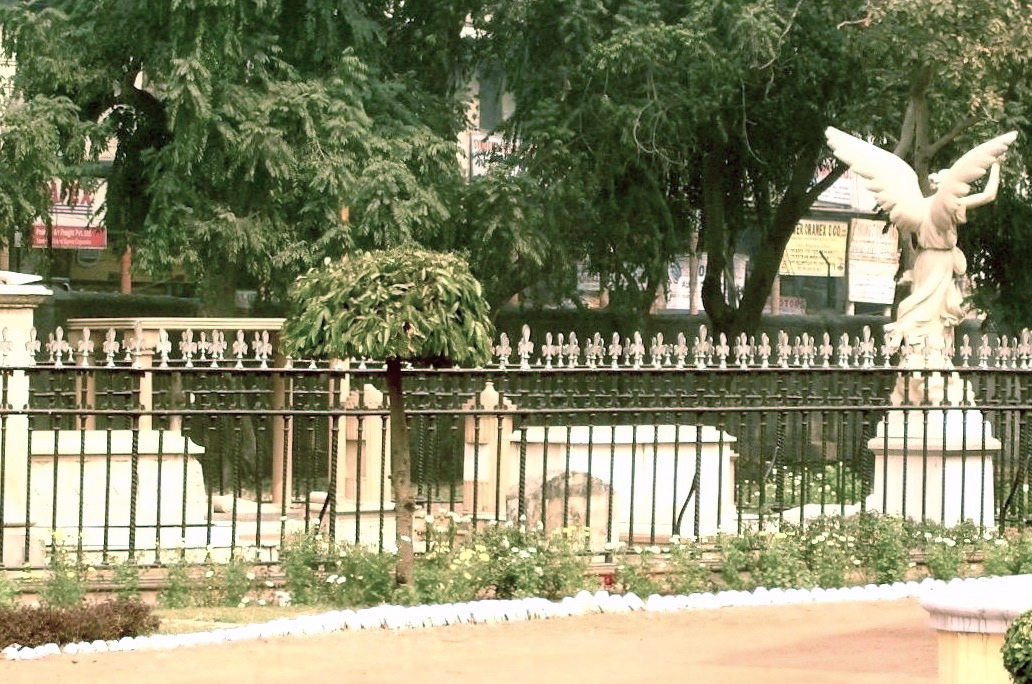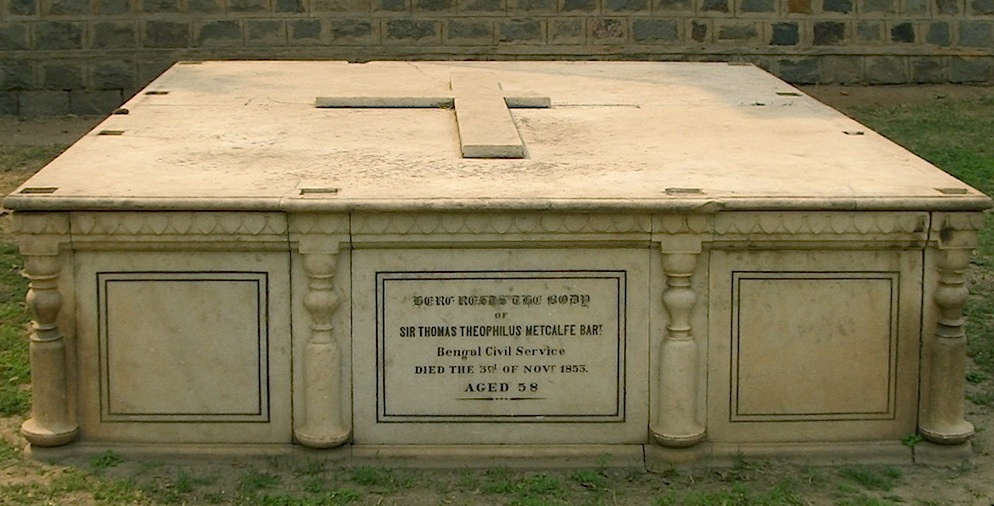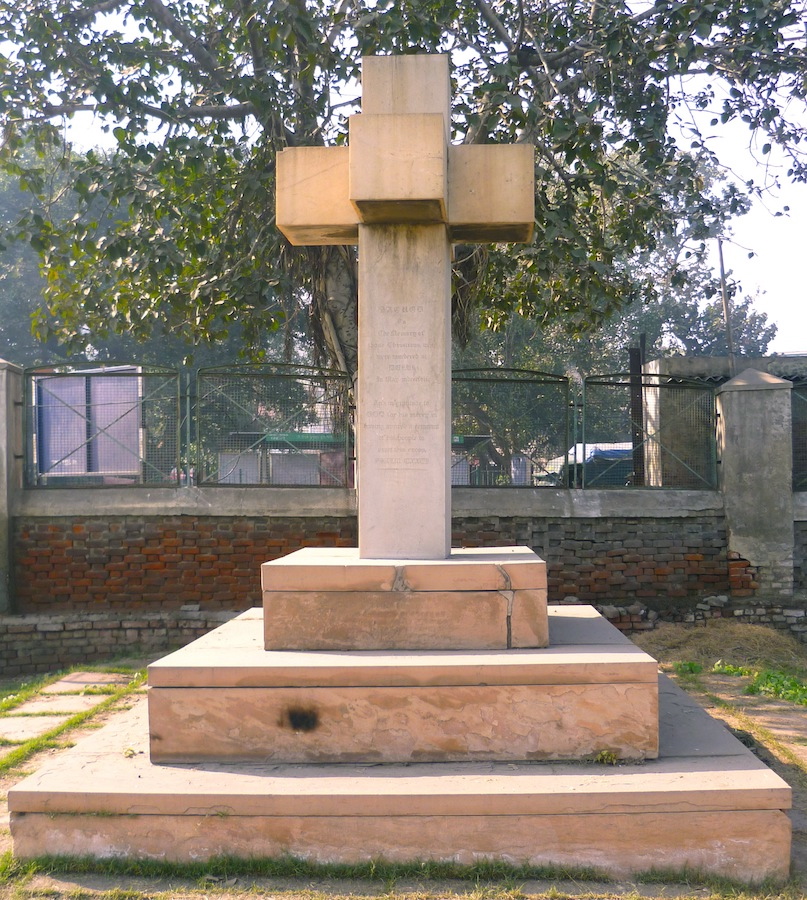Photographs and image download by the present author. You may use these images without prior permission for any scholarly or educational purpose as long as you (1) credit the photographer or source and (2) link your document to this URL in a web document or cite the Victorian Web in a print one. [Click on the images for larger pictures.]

St. James' Church from from the north-west.
St James' Church, close to the Kashmiri Gate in Old Delhi, is a rare example of a Palladian church in India (see Ten Churches of British India). The view above shows its west and north-west porticos, and the low square bell-tower added later, adjacent to the west portico. Even if it affects the church's symmetry, as Philip Davies suggests (145), the tower blends in well. But the architectural distinction of this Delhi landmark is only part of its interest. The oldest surviving church in Delhi, St James' is rich in history, and still reverberates with the complicated relationship between the two cultures that produced it.

St James' was built by one of the most colourful figures of pre-Raj India: Lt. Col. James Skinner (1778-1841), CB. He himself was a product of both cultures, the son of a Scottish mercenary and his well-born Rajputani wife, in the days when such marriages were acceptable (see Dalrymple 128). When Delhi was taken in 1803, Skinner was asked to raise three regiments of a thousand cavalrymen each, one of which he commanded himself. Pictured here in the frontispiece of the first volume of James Baillie Fraser's 1851 memoir of him, Skinner achieved superhero status through his exploits, notching up famous victories for the British. He built the church at his own expense, to fulfil a vow made when facing death in battle. Early records of the church were lost during the fierce fighting of the Sepoy Rebellion, but Skinner would have had expert help with the fine structure that arose slowly, over at least a dozen years, almost directly opposite his Delhi estate. An engraving of the church, dating from around the year that it was completed (1836), and preserved among the India Office materials at the British Library, carries the words, "Coll R.Smith and Capt. De Bude Engineers. Architects."
"Skinner's Church" meant a great deal to its founder, who, along with his three sons, was confirmed there in an emotional service at its consecration. An early coloured illustration of the church, dating from 1843, shows that it was once painted pink ("St Jame's [sic] Church"). But its present distinctive shade of yellow is much more appropriate. This was, after all, the colour that Skinner chosen for his famous unit — making it unique among Commonwealth regiments (A Living Witness, 9). His men's uniforms were conspicuous, of course. They were meant to be: "happy were the almost despairing gentlemen of Futtehpore and Mynpooree, when the yellow coats of 'Skinner's horse' made their appearance as their deliverers," says James Fraser at one point (2: 27). However, the church itself is not unique in this respect. Yellow is also associated with purity and holiness in India. Among others in the sub-continent painted in a similar shade are St John's Church, Meerut and Christ Church, Shimla.
Interior

St James' interior is well described by Jan Morris as "surprisingly spacious, enriched with Ionic pilasters and modillioned cornices," the walls "relieved by niches and circular recesses" (145). Again, it is full of history, harking back not only to Skinner and his circle but to the colonists of Victorian times, and, particularly, to the events of 1857.



Left to right: (a) James Skinner's final resting place, just below the altar rails. (b) The stained glass windows at the east, either side of the altar. (c) The marble font of 1899.
The arrangements and fittings are much as they would have been in the "home country" — but they all have their stories to tell. For instance, as founder of the church, Skinner is buried just where one might expect. But his body had earlier been interred, with all due military honours, at his military headquarters in Hansi in Haryana where he had died. Only after forty days was the coffin conveyed in state to Delhi, so that it could be placed in his own church, in accordance with his own wishes. Even then, it is not exactly where he had wanted: he had asked for it to be in the doorway, "so that all entering might trample over the chief of sinners" (qtd. in A Living Witness, 18).
From the church booklet we also learn that St James' stained glass windows date from the later 1850s/early 60s (21). Very traditional in themselves, and beautifully restored in 1996, these tell a story — or two — as well. The pair behind the altar tell the story depicted in most east windows, that of the Crucifixion and Resurrection. But a third window in the vestry shows soldiers terrified by the apparition of the risen Christ. This reminder, that there is a power greater than any human force, seems especially relevant to a church so intimately connected with battle.
The font is interesting from a different point of view. According to the same informative church booklet (20), it was designed by Col. Samuel Swinton Jacob (1841-1917). Jacob, since 1867 the chief engineer for Jaipur, was a pioneering architect in the Indo-Saracenic style, one of his more remarkable buildings outside Jaipur being the fabulous Gorton Castle in Shimla. He was also responsible for the original building of St Stephen's College, Delhi, founded by the Cambridge Mission and the SPG (Society for the Propagation of the Gospel), near the church. There too he incorporated Indo-Saracenic elements into his design. But the font is such as could be found in any British church of the period. Perhaps he felt that a church interior was not the place for exotic flourishes.
Memorials



Left to right: (a) Preserved relic of William Fraser's tomb. (b) 1884 Memorial to Alice Annie, wife of the youngest of Skinner's sons, Alexander. (c) Dignified memorial to Frederick Taylor, Principal of the nearby Delhi College.
Conveying the church's history most graphically are its memorials and monuments. Skinner is surrounded here by his family members and closest friends. By his own admission, no one was closer to him than the flamboyant Scotsman William Fraser (1774-1835), the Lieutenant-Governor's agent in Delhi, whose brother James wrote the first memoir of Skinner. A sample of exquisite inlaid work is all that remains of Fraser's once grand marble tomb, destroyed during the fighting in 1857. But there is still a slab outside inscribed according to Skinner's own instructions, expressing his shock at Fraser's assassination, and describing Fraser as being "as dear to him as life." Equally moving and beautiful, in its own way, is the memorial carved by Llewellyn and Company, the noted stonecutters of Calcutta, for a later Skinner, his daughter-in-law Alice Annie, who died at the age of 32.
Other poignant memorials, like that of the distinguished college principal Frederick Taylor, hark back to the dark days of the Sepoy Rebellion. This was a time when the dome's orb and cross were used for target practice and the church was "riddled with cannon-balls, filled with dying men and made a magazine for shot and shell" (qtd. in A Living Witness, 21). Relating to those events too is a tablet recording the death of Thomas W. Collins, Deputy Collector of Delhi. It is not an especially splendid one, but it carries a shocking roll-call of family members who also died at that time, including his wife, mother-in-law, four sisters-in-law, seven nephews and a nephew's infant son, three nieces, his own mother, and his brother, sister-law and nephew on that side. It was erected "by his surviving orphans."
St James' Grounds



Left to right: (a) The Skinner Cemetery. (b) Alexander Skinner's tomb. (b) An angel raises up one of the next generation, Alice Georgiana Skinner.
The church grounds are well kept but take up the same sad themes. Skinner had a number of wives and the Skinner Cemetery, railed off to the north, contains the tombs of many of the large Skinner clan. Here their family history is preserved in well-carved stone. Skinner's youngest son Alexander (1825-1885), the last to keep his father's estate intact (see Wheeler and Embree), has a particularly fine tomb. Alice Georgiana (1861-1923) was from the next generation: an inscription on the belfry, dated 1902, reveals that she was one of the two grandchildren who funded it. On the right side of her pedestal is a simple verse in two stanzas, a kind of lullaby starting, "Sleep safe free from care."

Not one of the clan, but another close friend of Skinner's, Sir Thomas Metcalfe (1795-1853), is also buried in the grounds. Metcalfe succeeded William Fraser as British Resident or agent in Delhi, and he was yet another of those larger-than-life figures that fill the pages of colonial history. A scholar of Indian culture, he converted the early seventeenth-century tomb of the Muslim Muhammad Quli Khan, to the south-west of the city, into his weekend retreat. He dined in the coffin space there, added new rooms to it, and filled the area around the tomb with terraces, water-features and follies.
A few others besides Skinner and his closest friends are buried at St James', including the first victim of the rebellion in Delhi, a young missionary of twenty-two, Daniel Corrie Sandys (1834-57). After seeing a child safely home, he was shot by mutinous sepoys (see Hammond 4-5). This tragedy heralded the church's darkest days. Facing the west entrance, on a stepped platform of local stone, is a stout Mutiny Memorial cross. It is inscribed to "the Memory of / those Christians, who / were murdered at / DELHI / in May mdccclvii, / And in gratitude to / GOD for his mercy in / having spared a remnant of his people to / erect this cross." This is poignant enough. But there was much to disturb us on the British side as well, for they exacted a terrible revenge in their subsequent retaking of Delhi.


Left: The Mutiny Memorial.
Right: The Parish Hall.
On a more cheerful note, and telling of continuity rather than change, behind the church are the Parish Hall and some parish homes for the aged. These were designed by Walter Sykes George (1881-1962), one of the architects who helped to build New Delhi (see Lang 8-11). He had stayed on in India, maintaining his practice there. The church buildings are humble but not without distinction. The same robust simplicity of style, with horizontals similarly relieved by colonial-style arches, can be found in one of his best-known projects — the new building for St Stephen's College (1941), which had now outgrown Jacob's premises. The scale is very different, of course, and that has a massive tower as well. All the same, the likeness can be seen.
Happily, St James' close association with Britain survived the deaths and departures of the early colonists and the traumas of 1857. One important reason for this continuity has been the Cambridge Brotherhood, later known as the Brotherhood of the Ascension, which was established in Delhi in 1877. The church's longest-serving minister so far has been the Rev. Ian Weathrall (1922-2013), a member of the Brotherhood. He had served in India during World War II, and then studied theology at King's College, London before returning to India in 1951. A list at the back of the church booklet shows that he was vicar there for nineteen years. According to his obituary in the Daily Telegraph, he was the last British missionary to northern India. An associated article in the online Telegraph describes him as "the last link to the British Raj." But such a link still exists in the church itself, and in the many others scattered all over the sub-continent, all with their own stories to tell.
Related Material
- Ten Churches of British India
- Another view of St James'
- St Stephen's Church, Delhi
- Sir Thomas Metcalfe's "Dilkusha" or "Heart's Delight" (his weekend retreat)
Sources
Dalrymple, William. City of Djinns: A Year in Delhi. London: Harper Perennial, 2005.
Davies, Philip. Splendours of the Raj: British Architecture in India 1660-1947. London: Penguin, 1987.
"Father Ian Weathrall." Obituary. Daily Telegraph. 15 May 2013.
"Father Ian Weathrall, last link to the British Raj, dies in India." The Telegraph. Web. 8 October 2014.
Fraser, James Baillie. Military Memoir of Lieut-Col. James Skinner, C. B. Volume 1 of 2. London: Smith, Elder & Co., 1851. Google Books. Free Ebook. Web. 8 October 2014.
Fraser, James Baillie. Military Memoir of Lieut-Col. James Skinner, C. B. Volume 2 of 2. London: Smith, Elder & Co., 1851. Internet Archive. Uploaded from the collections of Oxford University. Web. 8 October 2014.
Hammond, N. G. L. Sir John Edwin Sandys, 1844-1922. Pbk ed. Cambridge: Cambridge University Press, 2013.
"India Office Select Materials: Prints & Drawings full record display." British Library. Web. 8 October 2014.
Lang, Jon T. A Concise History of Modern Architecture in India. Delhi: Permanent Black, 2002.
A Living Witness (An Account of St James' Church and Its Builder). 3rd rev. ed. Kashmere Gate, Delhi: The Pastorate Committee, St James' Church, 1999.
Morris, Jan, with Simon Winchester. Stones of Empire: The buildings of the Raj. Oxford: Oxford University Press, 1983.
"St Jame's [sic] Church, with Tomb of William Fraser." British Library Online Gallery. Web. 8 October 2014.
"St Stephen's College: History." St Stephen's College. Web. 8 October 2014.
Wheeler, Stephen, rev. Ainslie T. Embree. "Skinner, James (1778–1841)." Oxford Dictionary of National Biography. Online ed. Web. 8 October 2014.
Last modified 8 October 2014